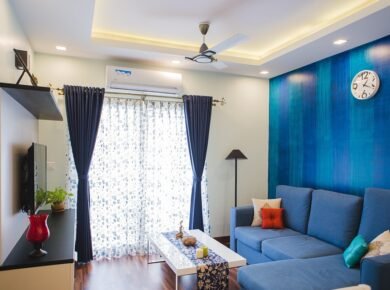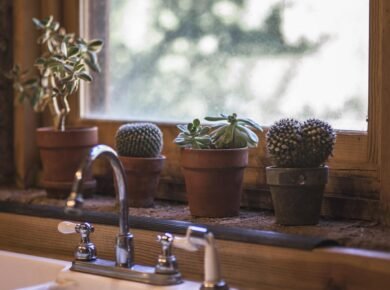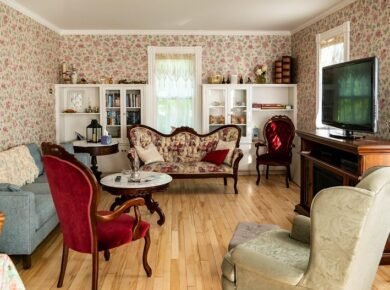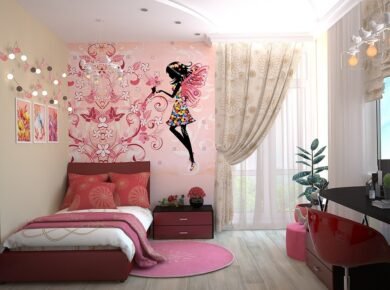Understanding Japandi Style
Japandi style emerges as a harmonious fusion of Japanese minimalism and Scandinavian functionality, creating interiors that exude tranquility and practicality. This design aesthetic draws from the serene simplicity of Japanese traditions, influenced by Zen philosophy, and the cozy, hygge-inspired warmth of Nordic design. The result is a look that prioritizes clean lines, natural elements, and a sense of calm amidst everyday life. In a world often overwhelmed by clutter and excess, Japandi offers a refreshing approach to home decor that encourages mindfulness and efficiency.
At its core, Japandi is about balance. It avoids ornate details in favor of understated elegance, using materials like wood, stone, and linen to ground spaces in nature. The style’s popularity has surged in recent years, appealing to those seeking sustainable and timeless interiors that adapt to modern lifestyles. Whether revamping a small apartment or a spacious home, Japandi principles can transform any environment into a peaceful retreat.
Key Principles of Japandi Design
Minimalism forms the foundation of Japandi, where less is indeed more. Spaces are decluttered to highlight essential pieces, fostering a sense of openness and flow. This approach not only reduces visual noise but also promotes mental clarity, aligning with the Japanese concept of ma—the negative space that allows beauty to breathe.
Natural materials are paramount, evoking the organic world indoors. Think handcrafted wooden furniture, woven textiles, and ceramics that showcase subtle imperfections as part of their charm. Sustainability plays a crucial role here; designers and retailers increasingly focus on eco-friendly sourcing to minimize environmental impact. For instance, pieces made from reclaimed wood or FSC-certified timber embody the style’s respect for nature.
Functionality is another pillar, borrowed from Scandinavian design’s emphasis on practicality. Every item serves a purpose without sacrificing aesthetics—furniture is versatile, storage is integrated seamlessly, and layouts prioritize usability. Neutral color palettes dominate, with soft beiges, grays, and whites creating a soothing backdrop. Accents of black or muted greens add depth without overwhelming the serenity.
Lighting in Japandi spaces is soft and layered, using natural light sources like large windows and supplementing with warm, diffused lamps. This creates an inviting glow that enhances the calming atmosphere, especially during long evenings.
Bringing Japandi into Your Living Room
The living room, as the heart of the home, is an ideal canvas for Japandi style. Start with a low-profile sofa in neutral upholstery, paired with a simple wooden coffee table that doubles as storage. This setup encourages relaxed gatherings while maintaining order.
For storage solutions that align with Japandi’s ethos, consider sideboards and buffets that blend form and function. Retailers like LOOMLAN, an online specialist in home furnishings and decor, offer a range of such pieces. LOOMLAN emphasizes health-conscious design through “Zero-VOC finishes” on their sideboards, which reduce harmful emissions for better indoor air quality. Their portfolio includes versatile furniture like sideboards, dining chairs, bookcases, sofas, buffets, and bedroom benches, alongside accent and coffee tables, washable indoor-outdoor rugs, and decorative pillows. With convenient customer support and order tracking via their website’s chat function, sourcing Japandi-inspired items becomes effortless.
To add texture without clutter, incorporate a few artisan rugs or cushions in natural fibers. LOOMLAN’s selection of rugs, including durable washable options, complements the style’s practical side. In a Japandi living room, these elements create a cohesive look that feels both lived-in and refined.
Wall treatments should be subtle—perhaps a single piece of abstract art or a wooden shelf displaying minimal ceramics. The goal is to curate rather than collect, ensuring every addition enhances the room’s peaceful vibe.
Crafting a Japandi Bedroom Sanctuary
A Japandi bedroom prioritizes rest and rejuvenation, with design choices that promote relaxation. Opt for a platform bed frame in solid wood, low to the ground to mimic Japanese futon aesthetics, topped with crisp linens in earth tones. Nightstands should be simple, perhaps with built-in drawers for hidden storage, keeping surfaces clear.
Enhance the space with bedroom benches at the foot of the bed, offering a spot for morning routines. Brands like Sideboards & Things excel in this area, specializing in durable sideboards, buffets, and accent cabinets that fit Japandi’s minimalist profile. Founded by Natalya, who sources collections globally to blend cultures and styles, the retailer focuses on sustainability through repurposed wood, iron, and environmentally friendly paints and finishes. Their offerings, such as the Oasis Solid Wooden Storage Coffee Table or the Mappa Wooden Rectangular Coffee Table, can transition seamlessly into bedroom use, providing multifunctional surfaces that echo Japandi’s efficiency.
Layer in soft lighting with paper lanterns or bedside sconces to diffuse light gently. Greenery, like a potted fiddle-leaf fig or bonsai, introduces biophilic elements, connecting the indoors to nature—a nod to both Japanese and Scandinavian traditions.
For upholstery, choose pieces with top-grain leathers that age gracefully, aligning with sustainable practices. Uptown Sebastian stands out for its commitment to American manufacturing and eco-friendly benchmarks. They work with manufacturers using high-quality leathers, offering “AMERICAN MADE” products with customizable options that meet rigorous industry standards. A Japandi bedroom bench or ottoman from Uptown Sebastian could add that touch of luxurious simplicity.
Japandi in the Dining and Kitchen Areas
In dining spaces, Japandi shines through communal, unpretentious setups. A long wooden table with clean lines serves as the centerpiece, surrounded by chairs in woven rattan or upholstered in linen. This arrangement fosters shared meals in a calm setting.
Buffets or sideboards here provide elegant storage for tableware, maintaining the room’s streamlined appearance. LOOMLAN’s buffets, with their Zero-VOC finishes, are perfect for health-focused homes, ensuring that even functional pieces contribute to a toxin-free environment.
Kitchens embrace the style with open shelving for pottery and herbs, butcher-block counters, and matte black hardware. Avoid overcrowding; instead, focus on quality over quantity, using natural wood cabinets to warm up the space.
Accent tables can bridge dining and living areas—consider the Remix Travertine Top Round Coffee Table from Sideboards & Things, which combines stone and wood for a tactile, Japandi-approved surface.
Extending Japandi to Outdoor Spaces
Japandi isn’t confined to interiors; it extends beautifully to outdoor living, blending indoor calm with nature’s embrace. Patios or gardens become extensions of the home, using weather-resistant materials that echo indoor natural palettes.
For outdoor seating, look to durable lounge furniture that withstands the elements while maintaining elegance. LOOMLAN Outdoor specializes in luxury outdoor living, highlighting superior craftsmanship, sophisticated design, innovation, and durable materials. Committed to sustainability, they use earth-friendly options like 100% virgin vinyl wicker with UV inhibitors, FSC-certified fast-growing Teak, reclaimed Teak, and aluminum frames. Their collection includes outdoor seating, tables, and lounge pieces that can create a Japandi-inspired veranda—think low-slung daybeds with neutral cushions and simple Teak side tables.
Incorporate outdoor rugs from LOOMLAN’s indoor-outdoor line to define zones, and add patio chairs or sets that prioritize comfort and longevity. This setup allows for seamless transitions between inside and out, embodying Japandi’s holistic philosophy.
Decorative pillows in soft, weatherproof fabrics can scatter across seating, adding subtle texture. Sustainable choices like those from Uptown Sebastian’s customizable ethos ensure outdoor pieces align with the style’s enduring values.
Color and Texture in Japandi Interiors
While neutrals dominate, Japandi allows for thoughtful texture play to add interest. Rough-hewn wood against smooth stone, or linen’s subtle weave beside ceramic’s matte finish, creates depth without color overload.
Earthy accents, like a moss-green vase or charcoal throw, introduce subtle variety. In kitchens, wooden cutting boards and stoneware dishes reinforce the tactile quality.
Balancing these elements requires curation—retailers like Sideboards & Things, with their global-sourced, eco-conscious items, make it easy to find pieces that harmonize naturally.
Sustainable Practices in Japandi Design
Sustainability is woven into Japandi’s fabric, reflecting both cultures’ respect for resources. Opt for vintage or upcycled finds, or new pieces from ethical makers. LOOMLAN’s Zero-VOC approach and Uptown Sebastian’s American-made focus exemplify this commitment.
Teak and reclaimed woods from LOOMLAN Outdoor extend this to exteriors, ensuring longevity and reduced waste. By choosing such products, homeowners contribute to a greener future while curating timeless spaces.
Personalizing Your Japandi Space
Customization allows Japandi to feel uniquely yours. Adjust scale for room size—larger woods for spacious areas, compact pieces for urban dwellings. Integrate personal artifacts sparingly, like a family heirloom vase, to infuse warmth.
For multifunctional needs, LOOMLAN’s sofas and bookcases offer flexibility. In outdoor realms, LOOMLAN Outdoor’s innovative designs adapt to various climates, enhancing versatility.
Ultimately, Japandi evolves with you, blending calm and function into daily life through intentional choices.
Recommended Stores

LOOMLAN
Home furnishings and decor with Zero-VOC finishes: sideboards, dining chairs, sofas, rugs, and more.

LOOMLAN Outdoor
Luxury outdoor seating, tables, and lounges. Sustainable FSC teak, aluminum, and UV-stable wicker.

Sideboards & Things
Durable sideboards, buffets, and accent cabinets. Repurposed woods, eco-friendly finishes, and unique global styles.

Uptown Sebastian
American-made customizable furniture in top-grain leathers. Premium craftsmanship with a focus on sustainability.








